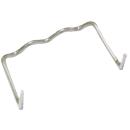Plastic bodywork welding clip

Plastic bodywork welding clip for cars
︾
Find our plastic bodywork welding staples for your repairs:
Plastic bodyworkwelding staples are fasteners used when repairing plastic components such as bumpers, body panels and other composite materials. These clips are specifically designed for use with plastic welding tools. Here are some important things to know about bodywork plastic welding staples:
Material and composition :
Plastic welding clips are generally made from materials that are compatible with plastic welding processes. The plastics most commonly used in car bodywork include polypropylene (PP), polyethylene (PE) and other thermoplastic polymers.
Compatibility with welding processes :
These staples are designed for use with plastic welding tools. Bodywork professionals use special hot air guns that heat the staple and the part to be repaired, fusing the plastic and producing a strong weld.
Repairing cracks and breaks:
Plastic welding clips are often used to repair cracks, breaks or chips in plastic bodywork components. They reinforce the structure and restore the integrity of the material.
Application on different components:
These clips are suitable for a variety of plastic components, including bumpers, grilles, side panels and other body components. They offer a practical solution for restoring parts rather than replacing them.
Variety of shapes and sizes:
Plastic welding clips are available in a variety of shapes and sizes to suit different repair geometries. This allows professionals to make precise repairs to various types of plastic components.
Aesthetic finish:
When used correctly, plastic soldering staples can provide a clean, unobtrusive aesthetic finish. This helps to preserve the original appearance of the component being repaired.
Solder joint strength:
Welds created using plastic solder staples can be very strong and durable, ensuring the stability of the repair over time.
It is important to note that the use of plastic welding clips requires expertise in plastic welding techniques. Trained bodyshop professionals can select and apply these staples to ensure robust and reliable repairs.
Using bodywork plastic welding staples:
Plastic welding staples are used in bodywork to repair damaged plastic components, such as bumpers, body panels and other composite components. Here are the general steps for using plastic welding clips in bodywork:
Surface preparation :
Before starting the repair, the surface of the plastic component should be thoroughly cleaned to remove dirt, grease and other contaminants. Make sure the area to be repaired is dry.
Selecting plastic welding clips:
Select the appropriate plastic welding staples according to the type of plastic used in the component and the nature of the repair. Staples are available in different shapes and sizes to suit different applications.
Placing plastic welding clips :
Place the staples along the crack, break or damaged area of the plastic component. Ensure that the staples are correctly positioned to provide optimum structural support.
Pre-heating the bodywork plastic welding staple:
Use a hot air gun specially designed for plastic welding to preheat the staple. Heat is applied directly to the staple until it reaches welding temperature.
Plastic welding :
Once the staple is pre-heated, apply it to the area to be repaired. The plastic of the clip should fuse with the plastic of the component, creating a strong weld. Some professionals also use special soldering irons for plastic soldering work.
Pressure and cooling:
Immediately after welding, apply light pressure to the staple using a suitable tool to ensure a tight bond. Then allow the staple to cool and harden completely.
Finishing:
After cooling, remove any excess material using appropriate finishing tools. The aim is to obtain a smooth, even surface.
Paint and aesthetic finish:
If necessary, paint the repaired component to match the vehicle's original colour. Bodywork professionals can use paint and finishing techniques to ensure an aesthetically pleasing appearance.


